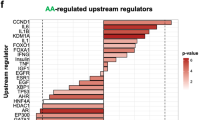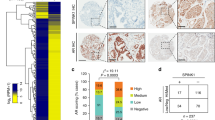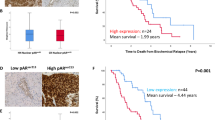Abstract
Doxazosin triggers apoptosis via an imprecisely defined receptor mechanism that is related to tumor necrosis factor receptors (TNFRs). The aim of this study was to determine CD95, TNFR-1, TNFR-2, CD40 expression in primary prostate epithelial cultures incubated with doxazosin. Epithelial cultures were cultivated from 10 benign prostate hyperplasia patients. The cells were incubated with 20, 50 and 80 μ M of doxazosin. Apoptosis was confirmed by fluorescence microscopy and flow cytometry. The cells were analyzed for expression of FAS, CD40, TNFR-1 and TNFR-2 by flow cytometry. Early apoptotic cells were present in all groups. A positive correlation was noticed between doxazosin dose and TNFR-1-, -2-positive cells. A decrease of CD40-positive cell population was observed in the lowest concentration. A decrease of mean fluorescence intensity signal of CD40 and CD95 was observed in the lowest concentration. Doxazosin-triggered apoptosis was dose-independent. The initiation of apoptosis was a result of receptors ‘crosstalk’ rather than a single receptor pathway activation. TNF receptor self-assembly process should be checked as a potential mechanism leading to apoptosis after doxazosin treatment.
This is a preview of subscription content, access via your institution
Access options
Subscribe to this journal
Receive 4 print issues and online access
$259.00 per year
only $64.75 per issue
Buy this article
- Purchase on Springer Link
- Instant access to full article PDF
Prices may be subject to local taxes which are calculated during checkout







Similar content being viewed by others
References
Kyprianou N, Benning CM . Suppression of human prostate cancer cell lines by a-1 adrenoreceptor antagonists doxazosin and terazosin via induction of apoptosis. Cancer Res 2000; 60: 4550–4555.
Siddiqui EJ, Shabbir M, Thompson CS, Mumtaz FH, Mikhailidis DP . Growth inhibitory effect of doxazosin on prostate and bladder cancer cells. Is the serotonin receptor pathway involved? Anticancer Res 2005; 25: 4281–4286.
Arencibia JM, Del Rio M, Bonnin A, Lopes R, Lemoine NR, Lopez-Barahona M . Doxazosin induces apoptosis in LNCaP prostate cancer cell line through DNA binding and DNA-dependent protein kinase downregulation. Int J Oncol 2005; 27: 1617–1623.
Tahmatzopoulos A, Sheng S, Kyprianou N . Maspin sensitizes prostate cancer cells to doxazosin-induced apoptosis. Oncogene 2005; 24: 5375–5383.
Keledjian K, Garrison JB, Kyprianou N . Doxazosin inhibits human vascular endothelial cell adhesion, migration, and invasion. J Cell Biochem 2005; 94: 374–388.
Shaw YJ, Yang YT, Garrison JB, Kyprianou N, Chen CS . Pharmacological exploitation of the alpha1-adrenoreceptor antagonist doxazosin to develop a novel class of antitumor agents that block intracellular protein kinase B/Akt activation. J Med Chem 2004; 47: 4453–4462.
Partin JV, Anglin IE, Kyprianou N . Quinazoline-based a-1-adrenoceptor antagonists induce prostate cancer cell apoptosis via TGF-b signalling and I-k-B a induction. Br J Cancer 2003; 88: 1615–1621.
Kyprianou N . Doxazosin and terazosin suppress prostate growth by inducing apoptosis: clinical significance. J Urol 2003; 169: 1520–1525.
Garrison JB, Kyprianou N . Doxazosin induces apoptosis of benign and malignant prostate cells via a death receptor-mediated pathway. Cancer Res 2006; 66: 464–472.
Sasaki Y, Ahmed H, Takeuchi T, Moriyama N, Kawabe K . Immunohistochemical study of Fas, Fas ligand and interleukin-1-b converting enzyme expression in human prostatic cancer. Br J Urol 1998; 81: 852–855.
Furuya Y, Fuse H, Masai M . Serum soluble Fas level for detection and staging of prostate cancer. Anticancer Res 2001; 21: 3595–3598.
Drewa T, Wolski Z, Skok Z, Czajkowski R, Wisniewska H . The FAS-related apoptosis signaling pathway in the prostate intraepithelial neoplasia and cancer lesions. Acta Pol Pharm 2006; 63: 311–315.
Coffey RN, Watson RW, Fitzpatrick JM . Signaling for the caspases: their role in prostate cell apoptosis. J Urol 2001; 165: 5–14.
Rokhlin OW, Bishop GA, Hostager BS, Waldschmidt TJ, Sidorenko SP, Pavloff N et al. Fas-mediated apoptosis in human prostatic carcinoma cell lines. Cancer Res 1997; 57: 1758–1768.
Frost PJ, Belldegrun A, Bonavida B . Sensitization of immunoresistant prostate carcinoma cell lines to Fas/Fas ligand-mediated killing by cytotoxic lymphocytes: independence of de novo protein synthesis. Prostate 1999; 41: 20–30.
Kischkel FC, Hellbardt S, Behrmann I, Germer M, Pawlita M, Krammer PH et al. Cytotoxicity-dependent APO-1 (Fas/CD95)-associated proteins form a death-inducing signaling complex (DISC) with the receptor. EMBO J 1995; 14: 5579–5588.
Scaffidi C, Fulda S, Srinivasan A, Friesen C, Li F, Tomaselli KJ et al. Two CD95 (APO-1/Fas) signaling pathways. EMBO J 1998; 17: 1675–1687.
Gewies A, Rokhlin OW, Cohen MB . Cytochrome C is involved in Fas-mediated apoptosis of prostatic carcinoma cell lines. Cancer Res 2000; 60: 2163–2168.
Rokhlin O, Glover RA, Cohen MB . Fas-mediated apoptosis in human prostatic carcinoma cell lines occurs via activation of caspase-8 and caspase-7. Cancer Res 1998; 58: 5870–5875.
Ashkenazi A, Dixit VM . Death receptors: signaling and modulation. Science 1998; 281: 1305–1308.
Lens SM, Tessellaar K, den Drijver BR, van Oers MH, van Lier RA . A dual role for both CD40-ligand and TNF-a in controlling human B cell death. J Immunol 1996; 156: 507–514.
Screaton G, Xu X-N . T cell life and death signalling via TNF-receptor family members. Curr Opin Immunol 2000; 12: 316–322.
Tourneur L, Buzyn A, Chiocchia G . FADD adaptor in cancer. Med Immunol 2005; 17: 1.
Roesler J, Izquierdo JM, Ryser M, Rosen-Wolff A, Gahr M, Valcarcel J et al. Haploinsufficiency, rather than the effect of an excessive production of soluble CD95 (CD95{D}TM), is the basis for ALPS Ia in a family with duplicated 3′ splice site AG in CD95 intron 5 on one allele. Blood 2005; 106: 1652–1659.
Calo LA, Pagnin E, Davis PA, Lodde M, Mian C, Semplicini A et al. Effect of doxazosin on oxidative stress-related proteins in benign prostatic hyperplasia. Urol Int 2006; 76: 36–41.
Konig JE, Senge T, Allhoff EP, Konig W . Analysis of the inflammatory network in benign prostate hyperplasia and prostate cancer. Prostate 2004; 58: 121–129.
Steiner GE, Stix U, Handisurya A, Willheim M, Haitel A, Reithmayr F et al. Cytokine expression pattern in benign prostatic hyperplasia infiltrating T cells and impact of lymphocytic infiltration on cytokine mRNA profile in prostatic tissue. Lab Invest 2003; 83: 1131–1146.
Stachon A, Schluter T, Koller M, Weisser H, Krieg M . Primary culture of microvascular endothelial cells from human benign prostatic hyperplasia. Prostate 2001; 48: 156–164.
Ricote M, Garcia-Tunon I, Bethencourt F, Fraile B, Onsurbe P, Paniagua R et al. The p38 transduction pathway in prostatic neoplasia. J Pathol 2005; 208: 401–407.
Zhao H, Lai F, Nonn L, Brooks JD, Peehl DM . Molecular targets of doxazosin in human prostatic stromal cells. Prostate 2005; 62: 400–410.
de Miguel MP, Royuela M, Bethencourt FR, Santamaria L, Fraile B, Paniagua R . Immunoexpression of TNF-a and its receptors 1 and 2 correlates with proliferation/apoptosis equilibrium in normal, hyperplasic and carcinomatous human prostate. Cytokine 2000; 12: 535–538.
Chan KF . The pre-ligand binding assembly: a potential target of inhibition of tumor necrosis factor receptor function. Ann Rheum Dis 2000; 59: 150–153.
Chan KF, Chun HJ, Zheng L, Siegel RM, Bui KL, Lenardo MJ . A domain in TNF receptors that mediates ligand-independent receptor assembly and signaling. Science 2004; 288: 2351–2354.
Palmer DH, Hussain SA, Ganesan R, Cooke PW, Wallace DM, Young LS et al. CD40 expression in prostate cancer: a potential diagnostic and therapeutic molecule. Oncol Rep 2004; 12: 679–682.
Eliopoulos AG, Davies C, Knox PG, Gallagher NJ, Afford SC, Adams DH et al. CD40 induces apoptosis in carcinoma cells through activation of cytotoxic ligands of the tumor necrosis factor superfamily. Mol Cell Biol 2000; 20: 5503–5515.
Angelucci C, Iacopino F, Lama G, Zelano G, Gianesini G, Sica G et al. Reverse transcriptase-PCR analysis of apoptosis-regulating gene expression in human benign prostatic hyperplasia. Anticancer Res 2005; 25: 3937–3941.
Ferguson TA, Griffith TS . A vision of cell death: insights into immune privilege. Immunol Rev 1997; 156: 167–184.
Dzojic H, Loskog A, Totterman TH, Essand M . Adenovirus-mediated CD40 ligand therapy induces tumor cell apoptosis and systemic immunity in the TRAMP-C2 mouse prostate cancer model. Prostate 2006; 66: 831–838.
Bugajska U, Georgopoulus NT, Southgate J, Johnson PW, Graber P, Gordon J et al. The effects of malignant transformation on susceptibility of human urothelial cells to CD40-mediated apoptosis. J Natl Cancer Inst 2002; 94: 1381–1395.
Acknowledgements
This work was supported by 2003 Pfizer Co. Competitive Awards Program.
Author information
Authors and Affiliations
Corresponding author
Rights and permissions
About this article
Cite this article
Drewa, T., Wolski, Z., Misterek, B. et al. The influence of α1-antagonist on the expression pattern of TNF receptor family in primary culture of prostate epithelial cells from BPH patients. Prostate Cancer Prostatic Dis 11, 88–93 (2008). https://doi.org/10.1038/sj.pcan.4500978
Received:
Revised:
Accepted:
Published:
Issue Date:
DOI: https://doi.org/10.1038/sj.pcan.4500978



